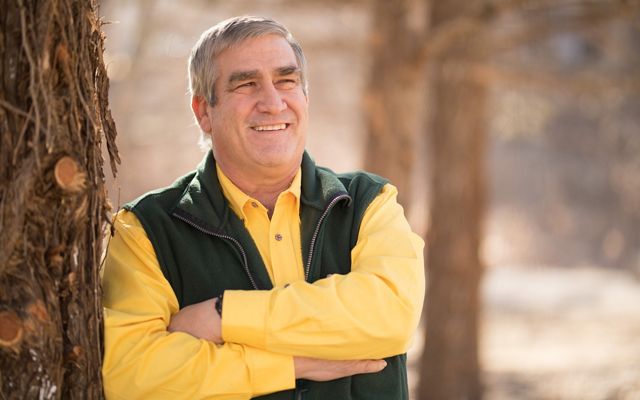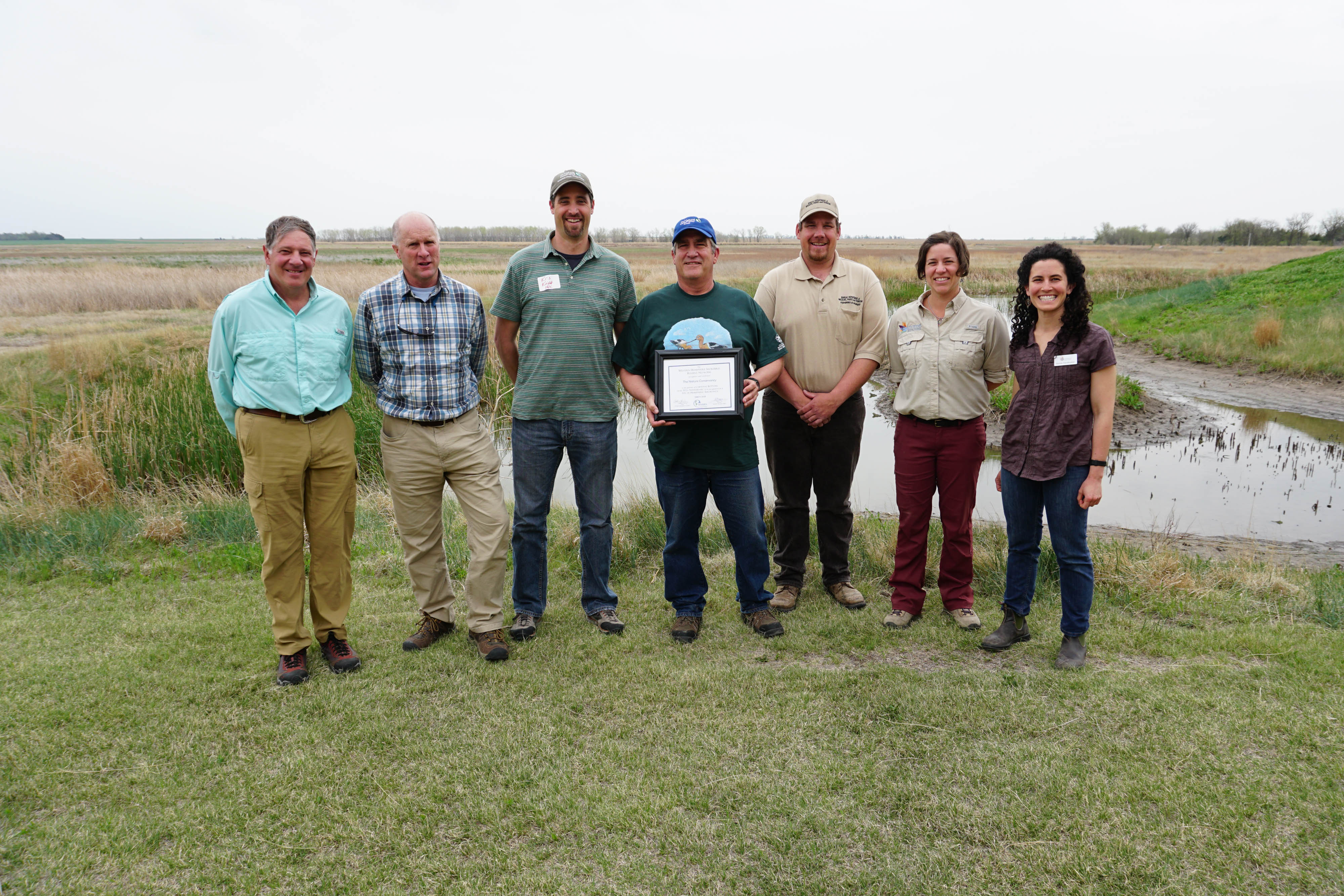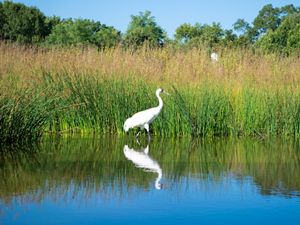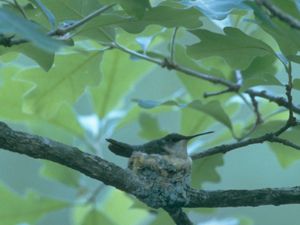Migratory Shorebird Conservation in the Central Flyway
Kansas wetlands and grasslands provide rest and refueling for birds in the Central Flyway.
At certain times of the year, there is a cacophony of sound rising up from Kansas. Rich, rollicking high-pitched sounds of “preets,” “kleets” and “yaps” fill the air from spring to fall as some of Kansas’ most beloved feathered visitors stop to rest and feed.
Avocets, black-necked stilts, killdeer and other shorebirds can be found on the mudflats of Cheyenne Bottoms and among the grasses and watering holes of the Flint Hills.
Fifty-seven species of shorebirds can be found in North America. Some migrate each spring from South America to the Arctic Circle to breed and raise their young before making the grueling 7,000 to 8,000-mile return trip. And each year, they contend with diminishing wetlands and prairies, invasive plants, predators and changes to the way land is used.
"You can imagine a little bird like the white-rumped sandpiper—just a little bigger than a house sparrow—having to travel all that way and not being able to stop on a regular basis," said Robert Penner, Cheyenne Bottoms and Kansas Avian Programs Manager for The Nature Conservancy.
Quote: Robert Penner, PhD
Cheyenne Bottoms is one of the key stopover sites through the Central Flyway on both the north and south routes. We are just a very important link in the chain of wetlands.”

Only two states in the U.S. can make the claim of having two wetlands of international importance: Florida and Kansas.
Cheyenne Bottoms in Barton County received the designation in 1988, and the accolades have continued. The Western Hemisphere Shorebird Reserve Network denoted it a site of hemispheric importance. It was the first to receive The National Audubon Society's Globally Important Bird Area description. Thirty miles to the south, Quivira National Wildlife Refuge is similarly distinguished.
As the largest marsh in the interior of the U.S., Cheyenne Bottoms is critical habitat for migrating birds including many species of sandpiper, dowitchers and Wilson's phalaropes.
Not Just Wetlands
The rolling tallgrass prairie of the Flint Hills in eastern Kansas is also vital for shorebird conservation. The region was designated a Landscape of Hemispheric Importance by the Western Hemisphere Shorebird Reserve Network. It was only the second landscape in the nation to earn the distinction. The first was the Rainwater Basin in Nebraska where tens of millions of waterfowl descend each spring.
It is estimated that more than 225,000 shorebirds use the Flint Hills each year to stop, rest and refuel on their migrations.
"With shorebirds, you think of something running along the shore, any kind of shore from shallow water to mudflats," says Penner. "But there is actually a group of shorebirds that are considered 'grassland dependent'. These are the species that come through the Flint Hills to stop and feed on dry land."
The buff-breasted sandpiper has a world population between 56,000 to 80,000 birds.
"Almost the entire population of buff-breasted sandpiper comes right through the Flint Hills each year," adds Penner.
Penner is a member of a multi-agency working group to implement a conservation plan for the species.
Quote: Robert Penner, PhD
Almost the entire population of buff-breasted sandpiper comes right through the Flint Hills each year.

The Evolution of a Legacy
For years, Cheyenne Bottoms was just mucky, marshy land.
Its name came from the Cheyenne Indians who frequented the area before colonization and Euro-American settlement. Legend has it that a 19th century battle in the area between the Cheyenne and a warring tribe turned a neighboring creek red with blood—thus earning the creek’s name, Blood Creek. The earliest roots of national greyhound racing began at Cheyenne Bottoms in 1886 with coursing events.
By 1923, there was a man in the area, Frank Robl of Ellinwood, who started banding the ducks and geese he found at Cheyenne Bottoms. It was a hobby. He had a farm on the south shore of what was then called Cheyenne Swamp, now the Cheyenne Bottoms Wildlife Area. In his spare time, Robl drove around the swampy land. He fashioned his duck and geese bands from tin, curious about where the birds went each fall and spring migration.
Robl kept meticulous records of his discoveries.
"In five years, I had recoveries from as far as Alaska and Canada, Mexico and Central America," Robl wrote in The 'Duck Man' Writes About Cheyenne Bottoms.
In 1934, he accompanied a delegation to the American Game Conference in New York City. He spoke on national radio about his findings and spent five days in Washington, D.C., with Kansas politicians, including Vice President Charles Curtis.
Robl's records helped document the route of the Central Flyway, the bird migration route through the Great Plains from Canada to South America.
Seventy percent of all the different shorebird species in North America have been recorded Cheyenne Bottoms. Up to a quarter million waterfowl stop to rest and feed each year.
Cheyenne Bottoms is now a 41,000-acre, 64-square-mile wetland basin sink. This includes the 19,857-acre Cheyenne Bottoms Wildlife Area managed by Kansas Wildlife, Parks and Tourism and The Nature Conservancy's nearly 8,000 acre Cheyenne Bottoms Preserve.
The Nature Conservancy began purchasing land at Cheyenne Bottoms in 1990, when less than half of the basin was protected as a wildlife area.
"In the 1980s, people were concerned that the Bottoms were drying up, concerned that due to diversions upstream, Cheyenne Bottoms would not get the water it had a legal right to." Penner says. "The state Water Resources Office made changes so now, if water comes down the Arkansas River and Wet Walnut Creek, Cheyenne Bottoms gets its water. Still, we are at the mercy of Mother Nature. We've got to have rain and enough of it so rivers and streams flow."
The Greatest Threats
The fragility of both Kansas wetlands and grasslands is of interest worldwide. Each are a link in the chain of rest and refueling sites along the Central Flyway.
“The main threats are water use and habitat management,” says Monica Iglecia, assistant director of Shorebird Habitat Management at Manomet, Mountain View, CA. “Development and human disturbance, which many times is recreation, disturbs birds during migration. So, the birds are not able to rest and refuel.”
Invasive plants, like reeds and cattails, threaten to take over some wetlands. And there are predators: racoons, coyotes, dogs and cats.
"Cheyenne Bottoms is like a bullseye for birds flying over the mid-continent United States," Iglecia says. "It is this big body of water and that is what they are looking for. It has reliable habitat that has food in it that they can eat."
Shorebirds in Kansas






Current Work and Discoveries
Careful observation of birds at Cheyenne Bottoms still takes place.
Recently, a student from South Carolina banded a Hudsonian godwit in Chile. The bird flew nonstop to Cheyenne Bottoms in just six days, covering a distance of more than 8,690 miles.
"It was here for five days and two days later was up in South Dakota," recounts Penner. "These birds are moving fast during the spring. They need to get to the Arctic Circle to get their business done. So, can you image that poor bird if it couldn't find Cheyenne Bottoms or Quivira after six straight days of flight?"
Every 10 days, a survey is done to see what new species have shown up. The average stay of most shorebirds at Cheyenne Bottoms is eight to 10 days.
"On average, you have a complete turnover of shorebirds every 10 days," says Penner. "They feed on blood worms and other invertebrates like insect larvae. The blood worms are found all over. But in this region, they are fairly common, even abundant," he says.
"The worms are found in such high numbers, the shorebirds find a dependable and easily accessible food source. When the shorebirds are out foraging in shallow water and mud flats, it is important they get something as many times as they try. They have to almost double their weight when they are here because they have used up all their reserves. They have to build that back up before they can move on."
Robert Penner has his doctorate in ornithology, the scientific study of birds, and shorebirds are his expertise. He's been working at Cheyenne Bottoms since 1996, but in recent years he has represented The Nature Conservancy to work on issues at an international scale.
In October 2019, he presented at the Western Hemisphere Shorebird Group conference in Panama, showcasing important bird sites along the Central and Mississippi Flyways. He's also on a multi-country steering committee developing a conservation plan for shorebirds spanning Canada, the United States, central America and South America. Penner continues to work extensively with the Western Hemispheric Shorebird Reserve Network and has garnered the respect of birders around the world.
So why care about these birds that spend such a short time among the marshes and grasslands of Kansas?
"There are many wetlands that get a lot of airtime, such as San Francisco Bay. Many people know about San Francisco Bay," Iglecia says. "But very few people know about Cheyenne Bottoms. We need more people to know about Cheyenne Bottoms. I think of Sylvia Earle, a well-known marine biologist, who says 'you cannot protect what you don't know.' The more we talk about Cheyenne Bottoms as this anchor of wetlands in the mid-continent, the more people will care and the more we can work together."
And, as for those birds?
“Migratory birds, like the shorebirds, connect us,” adds Iglecia. “They are opportunities to connect people at the sites along the flyways, whether biologists or members of the public. These are challenging social times. There are lots of ways to divide us, but shorebirds offer an opportunity to bring us together.”
Quote: Monica Iglecia
There are lots of ways to divide us, but shorebirds offer an opportunity to bring us together.

By Robert L. Penner, PhD
Mid-Continent Shorebird Conservation Initiative
The mid-continent regions of North and South America provide critical breeding, migration stopover and nonbreeding habitat for numerous resident and migratory shorebirds. Fifty-seven percent of 45 shorebird populations using the mid-continent region of Canada and the United States have shown long-term population declines, whereas only 9% show any type of increase. In South America, several Andean and interior lowland shorebirds are considered globally Near Threatened with extinction. The Mid-continent Americas host a pre-breeding population of more than 15.8 million shorebirds during migration—more than the Pacific Americas (8.3 million) and Atlantic Americas (5.3 million) combined. Despite the importance of this area to shorebird populations, there hasn't been a coordinated, full annual-cycle approach to shorebird management until now. The Mid-continent Shorebird Conservation Initiative will complement conservation initiatives developed in the Atlantic and Pacific Americas Flyways and complete a comprehensive approach to shorebird conservation in the Americas. It is great to share with you the news that the Mid-continental Flyway Shorebird Conservation Strategy Planning Workshop held in Panama on 29-30 October 2019 was a success. It was an intense and very interesting process that was enriched with the participation of 30 conservationists and researchers from 12 different countries along the Mid-continental Flyway. We agreed on the geography and boundaries of the flyway, as well as an initial list of species and threats. The governance and next steps were also discussed, and a North American sub-committee with state, NGO and government agencies was formed. Three more workshops will held over the next three years to ensure we gather input from as many shorebird experts as possible. This will be a major undertaking but one that will be very important to sustain a suite of shorebird populations for present and future generations.



